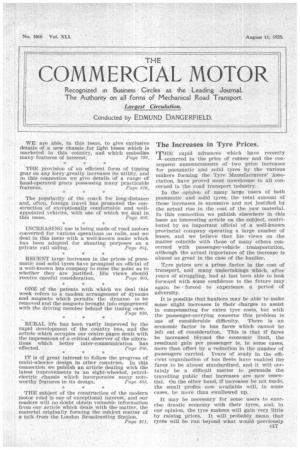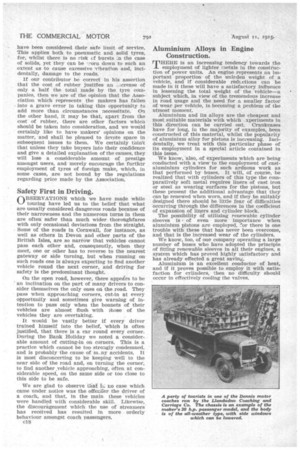The Increases in Tyre Prices.
Page 1

Page 2

If you've noticed an error in this article please click here to report it so we can fix it.
rrnE rapid advances which have recently occurred in the price of rubber and the consequent announcements of two price increases for pneumatic and solid tyres by the various makers forming the Tyre Manufacturers' Association, have proved most unwelcome to all concerned in the road transport industry.
In the opinion of many large users of both pneumatic and solid tyres, the total, amount of these increases is excessive and not justified by the actual rise in the cost of the raw material. In this connection we publish elsewhere in this issue an interesting article on the subject, contributed by an important official of a well-known -provincial company operating a large number of buses, and we believe that his views on the matter coincide with those of many others concerned with passenger-vehicle transportation, although the actual importance of the increase is almost as great in the case of the haulier.
Tyre prices are a prime factor in the cost of transport, and many undertakings which, after years of struggling, had at last been able to look forward with some confidence to the future may again be forced to experience a period of adversity.
it is possible that hauliers may be able tomake some slight increases in their charges to assist in compensating for extra tyre costs, but with the passenger-carrying concerns this problem is one of considerable difficulty. There is an economic factor in bus fares which cannot be left out of consideration. This is that if fares be increased lAyond the economic limit, the resultant gain per passenger is, in some cases; more than offset by a reduction in the number of passengers carried, Years of study in the efficient organization of bus fleets have enabled the fares to be almost standardized, and it will certainly be a difticUlt matter to persuade the travelling public that increases are new essential. On the other hand, if increases be not made, the small profits now available will, in some cases, be more than swallowed up.
It may be necessary for some users to exercise drastic economy with their tyres, and, in our opinion, the tyre makers will gain very little by raising prices. It will probably mean that tyres will be run beyond what would previously have been considered their safe limit of service. This applies both to pneumatic and solid tyres, for, whilst there is no risk cf bursts :n the ease of solids, yet they can be -7orn down to such an extent as to cause excessive 'vibration and, incidentally, damage to the roads.
If our contributor be correct in his assertion that the cost of rubber justifies an .1_1crease of only a half the total made by the tyre companies, then we are of the opinion that the Association which represents the makers has fallen into a grave error in taking this opportunity to add more than circumstances necessitate. On the other hand, it may be that, apart from the cost of rubber, there are other factors which should be taken into consideration, and we would certainly like to have makers' opinions on the matter, and shall be pleased to devote space in subsequent issues to them. We certainly think that unless they take buyers into their confidence and give a detailed explanation of the causes, they will lose a considerable amount of prestige amongst users, and merely encourage the furthsr employment of tyres of foreign make, which, in some cases, are not bound by the regulations regarding price made by the -Association.
Safety First in Driving.
OBSERVATIONS which we have made while touring have led us to the belief that what are usually considered dangerous roads because of their narrowness and the numerous turns in them are often safer than much wider thoroughfares with only occasional deviations from the straight. Some of the roads in Cornwall, for instance, as well as others in Devon and other parts of the British Isles, are ,so narrow that vehicles cannot pass each other and, consequently, when they meet, one or other has to reverse to the nearest gateway or side turning, but when running on such roads one is always expecting to find another vehicle round the next corner, and driving for safety is the predominant thought.
On the open road, however, there appetfrs to be ' an inclination on the part of many drivers to consider themselves the only ones on the road. They pass when approaching corners, cut-in at every opportunity and sometimes give warning of intention to pass only when the bonnets of their vehicles are almost flush with those of the vehicles they are overtaking.
It would be vastly better if every driver trained himself into the belief, which is often justified, that there is a car round every corner. During the Bank Holiday we noted a considerable amount of cutting-in on corners. This is a practice which cannot be to strongly condemned, and is probably the cause of m_ny accidents. It is most disconcerting to be keeping well to the near side of the road and, on turning the corner, to find another _vehicle approaching, often at considerable speed, on the same side or too close to this side to be safe.
We are glad to observe that k. no case which came under, notice was the offer:der the driver of a coach, and that, in the main these vehicles were handled with considerable skill. Likewise, the discouragement which the use of streamers has received has resulted in more orderly behaviour amongst coach passengers.
c18 Aluminium Alloys in Engine Construction.
THERE is an increasing tendency towards the employment of lighter metals in the construction of power units. An engine represents an important proportion of the unle den weight of a vehicle, and if considerable reductions can be made in it these will have a satisfactory influence in lessening the total weight of the vehicle—a subject which, in view of the tremendous increase in road usage and the need for a smaller factor of wear per vehicle, is becoming a problem of the utmost moment.
Aluminium and its alloys are the cheapest and most suitable materials with which .xperiments in this direction can be carried out. Crankcases have for long, in the majority of examples, been constructed of this material, whilst the popularity of aluminium alloy for pistons is increasing. Incidentally, we treat with this particular phase of its employment in a special article contained in this issue.
We know, also, -of experiments which are being conducted with a view to the employment of castaluminium cylinders for such arduous work as that performed by buses. It will, of course, be realized that with cylinders of this type the comparatively soft metal requires liners of cast iron or steel as wearing surfaces for the pistons, but these present the additional advantage that they can e renewed when worn, and if they be suitably designed there should be little fear of difficulties occurring through the differences in the coefficient of expansion of liners and cylinder block.
The possibility of utilizing renewable cylinder sleeves is • of even more importance when aluminium pistons are employed, ?or there is one trouble with these that has never been overcome, and that is the increased wear of the cylinders.
We know, too, of one company operating a large number of buses who have adopted the principle of fitting renewable sleeves in all their engines, a system which has proved highly satisfactory and has already effected a great saving.
Aluminium is an excellent conductor of heat, and if it proves possible to employ it with satisfaction for cylinders, then no difficulty should occur in effectively cooling the valves.






























